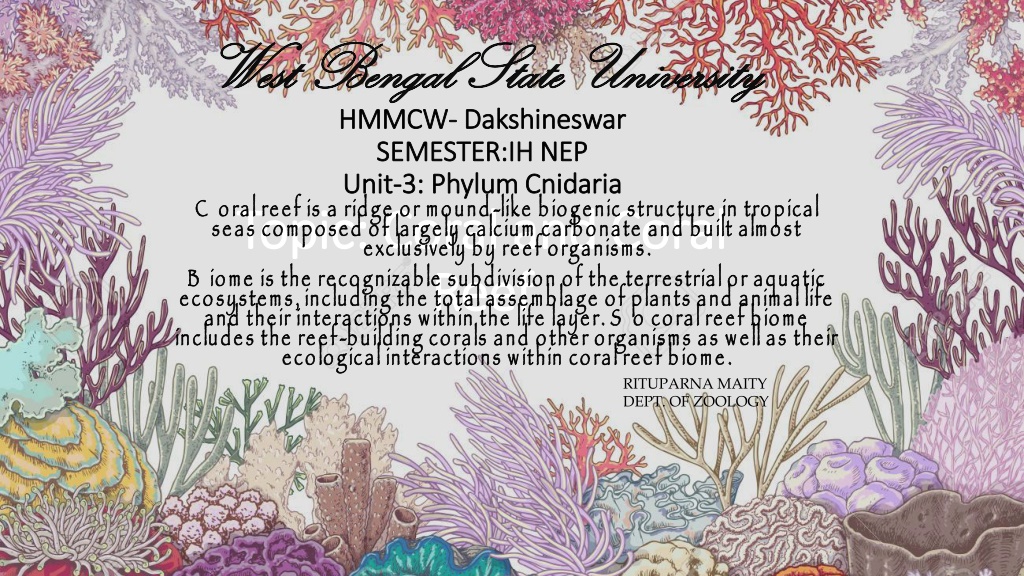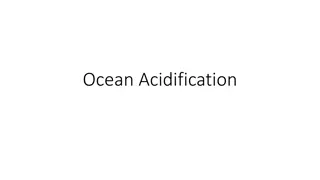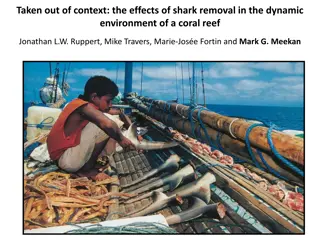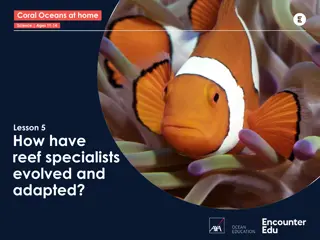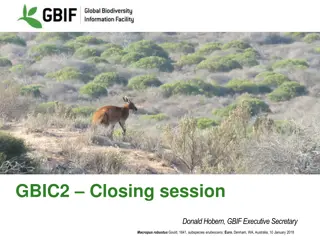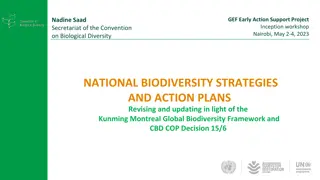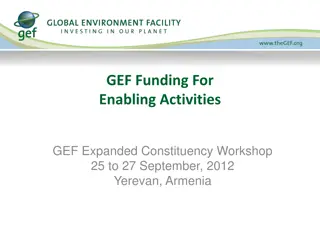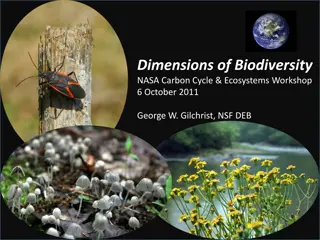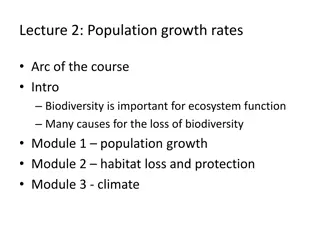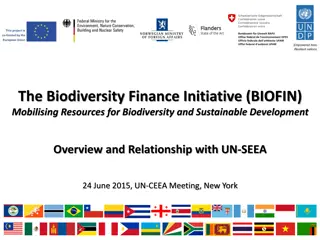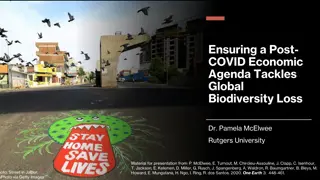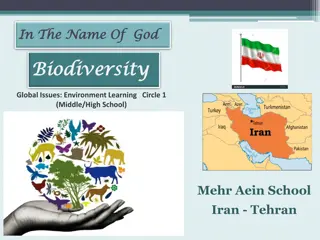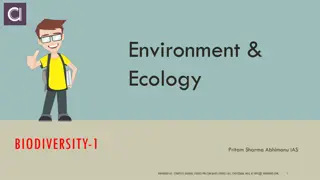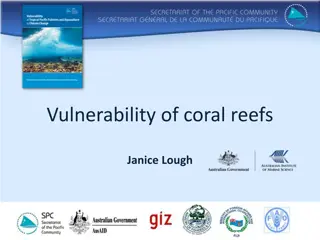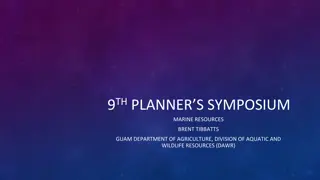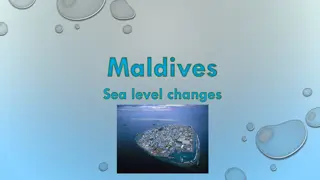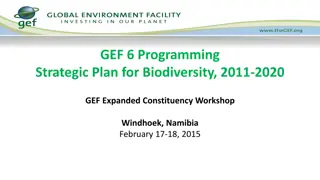The Fascinating World of Coral Reefs and Their Biodiversity
Coral reefs are vital biogenic structures formed by reef-building corals and various marine organisms. These ecosystems, found in diverse regions like the Caribbean, Indo-Pacific, Fiji, and Bermuda, host a rich array of flora and fauna, including corals, fish, turtles, and sea snakes. The intricate interactions within coral reef biomes support a complex food web, with calcareous coralline seaweeds also playing a role. The beauty and importance of coral reefs highlight the need for their conservation and protection.
Download Presentation

Please find below an Image/Link to download the presentation.
The content on the website is provided AS IS for your information and personal use only. It may not be sold, licensed, or shared on other websites without obtaining consent from the author. Download presentation by click this link. If you encounter any issues during the download, it is possible that the publisher has removed the file from their server.
E N D
Presentation Transcript
West Bengal State University West Bengal State University HMMCW HMMCW- - Dakshineswar Dakshineswar SEMESTER:IH NEP SEMESTER:IH NEP Unit Unit- -3: Phylum Cnidaria 3: Phylum Cnidaria Topic: Coral and Coral Topic: Coral and Coral Reef Reef and their interactions within the life layer. S o coral reef biome includes the reef ecological interactions within coral reef biome. C oral reef is a ridge or mound seas composed of largely calcium carbonate and built almost exclusively by reef organisms. B iome is the recognizable subdivision of the terrestrial or aquatic ecosystems, includ and their interactions within the life layer. S o coral reef biome includes the reef- -building corals and other organisms as well as their ecological interactions within coral reef biome. C oral reef is a ridge or mound- -like biogenic structure in tropical seas composed of largely calcium carbonate and built almost exclusively by reef organisms. B iome is the recognizable subdivision of the terrestrial or aquatic ecosystems, including the total assemblage of plants and animal life building corals and other organisms as well as their like biogenic structure in tropical ing the total assemblage of plants and animal life RITUPARNA MAITY DEPT. OF ZOOLOGY
Corals have built a thick stratum of the earths crust, they have coral reefs in the Caribbean seas and in the Indo-Pacific region from east coast of Africa to the north-eastern coast of Australia which is known as the Great Barrier Reef. However, Fiji islands of Pacific Ocean and those situated in Bahama islands region are the best known coral islands of the world. Bermuda is a coral island where houses are built of coral blocks. Around India, coral reefs are found off Port Okha and Dwarka in the gulf of Kutch and also off Rameshwaram in the gulf of Mannar between India and Sri Lanka. The correefs are also located at Andaman and Nicobar islands and at Lakshadweep Islands. Vaughan (1917) has defined coral reef as a ridge or mound of lime stone, the upper surface of which is near the surface a ridge or mound of lime stone, the upper surface of which is near the surface of the sea and which is formed of calcium carbonate by the actions of organisms, chief of the sea and which is formed of calcium carbonate by the actions of organisms, chief produced by corals belonging to Anthozoa Anthozoa, particularly by stony corals, the Madreporarialy ly corals. e.g., Astraea, Flabellum, Favia, etc.(ii) Perforate corals (ii) Perforate corals, e.g., Porites, Madrepora, Montipora, Acropora and sometimes and sometimes Tubipora Tubipora and and Heliopora Heliopora; the much calcified ; the much calcified alcyonarians alcyonarians like Mollusc shells and skeleton of Foraminifera (shelled protozoa), sponges, sea anemones, flatworms, shrimps, crabs, lob- sters, octopuses, squids, some snails, bivalves, starfishes, sea urchins, sea cucumbers, tunicates, turtles, sea snakes and many reef fishes that include sharks, eels and rays form an important constituent of the coral reefs. Pillai (1986) has recorded different kinds of fishes, turtles, dugongs as coral fauna in the Gulf of Mannar. He has recorded the different kinds of fishes, such as butterfly fish ( butterfly fish (Chaetodon Chaetodon sp spp.), snapper ( spp.), snapper (Lutjanus Lutjanus spp spp.) and the eels .) and the eels Gymnothorax Gymnothorax undulatus undulatus and The green turtle ( green turtle (chelone chelone mydas mydas), Olive turtle ( ), Olive turtle (Lepidochelys Lepidochelys olivacea olivacea), sea snakes, dugongs ( grasses grasses are present in this area. Turtles and dugongs are dependent on sea grasses. These inhabitants when exposed to low tide are subjected to predation by birds, such as gulls and golden plover, etc. A few of the above mentioned species feed directly on corals, and others graze on algae and participate in food webs. Calcareous coralline sea weeds are Lithophyllum, Lithothamnion and Melobasia of the red algae, Helimedia of green algae recorded in the coral reef areas. Biome is the recognisable subdivision of the terrestrial or aquatic ecosystems, including the total assemblage of plants and animal life and their interactions within the life layer. So coral reef biome includes the reef-building corals and other organisms as well as their ecological interactions within coral reef biome. corals. - - (i) Imperforate corals (i) Imperforate corals, Porites, Madrepora, Montipora, Acropora, etc.; .; Milliporans like Fungia Fungia, , etc. and the gorgonarians Milliporans gorgonarians. sp.) .), parrot fish ( parrot fish (Scarus and Gymnothorax Gymnothorax punctatus ), sea snakes, dugongs (Dugong Scarus spp spp.), squirrel fish ( .), squirrel fish (Holocentru punctatus, etc. Dugong dugon dugon) ) and algal sea Holocentrus s algal sea
Structure: The structure of a corallum will be clear from the detailed structural organisation of a single corallite. Each corallite consists of a cup containing vertical ridges radiating from the centre to the periphery. The bottom of the cup beneath the polyp is designated as the basal plate. The wall of the cup enclosing the aboral portion of the polyp is termed as the theca. The ridges of the cup are called the skeletal septa or sclerosepta. The formation of theca may be an independent process or may arise by the fusion of the outer ends of the sclerosepta and the theca thus formed are called the pseudotheca. The inner ends of the sclerosepta are fused to a central columnar skeletal mass, termed as the columella which may arise independently as the outgrowth of the basal plate or may be formed by the union of the central ends of the sclerosepta. The columella formed by the last process is termed as the pseudocolumella. A secondary wall or epitheca may be formed outside the theca. The epitheca is separated from the theca by a space and this space is crossed by continuations of the sclerosepta called the costae. Small ridges called the pali are present between the columella and the main parts of the sclerosepta. There are horizontal plates between sclerosepta, which, when incomplete, are called dissepiments and when complete, are known as tabulae. The sclerosepta are usually spiny. The sclerosepta present in a corallite are definitely related to septa and typically occur in hexamerous cycles: 6 primaries, 6 secondaries, 12 tertiaries; 24 quareternaries, etc. The sclerosepta are comrrtonly endocoelic in origin. Corals are divided into several types depending upon the habit or association and upon the structure. On On the the basis basis of of its its association, association, the the corals corals can Solitary and Colonial On On the the basis basis of of its its structural structural organisation organisation, , the three three types types- - can be be divided divided into into two two types types the corals corals can can be be divided divided into into
Formation of Coral Formation of Coral: The coral reefs grow best at a depth of about 30 metres or less and normally in warm water up to about 20 C. Light and amount of sediment also limit the reef forming corals. They also fail to grow in dark shaded areas and they completely die in total darkness. Below 50 metres no reef building corals are found though some solitary corals exist up to 8000 metres. The actual method of secretion of coral and the subsequent stage of formation are not very clearly understood. But the following account will give an idea about its formation. Secretion of coral does not commence until twelve primary mesenteries are attained by the polyp. Secretion of calcareous materials which either immediately crystallise or crystallised by the interaction with chemical substances present in sea water, transforms into a calcareous mass. The calicoblast layer forms minute nodules at the base of polyp. The nodules unite to form prototheca which becomes gradually thickened and later assumes a cup-shaped structure. At this stage the body- wall of the living polyp may or may not overflow the edge of prototheca. In the former case, the growth of the prototheca is brought about by the calicoblasts. The cup is now called the theca and the overflowed tissue is called the episarc. The episare of the primary zooid thus overflowed on the substratum, gives rise to the successive layers of skeleton, called the Coenenchyma . By the process of asexual reproduction new zooids are developed near the primary one. The episarc, independent theca and septa are gradually formed in secondary zooids also. The skeleton of different zooids remains intercon- nected with the primary one. Many corallites constituting the corallum are formed. Separate film of skeletal material is formed outside the theca and this layer is called the epitheca. Six to twelve ectodermal infolding s are formed at the base of the polyp. Secretion of skeletal material in those grooves takes place and sclerosepta are formed within the theca. Gradually the secondary and tertiary sclerosepta are developed in spaces between mesenteries and they alternate with the mesenteries. The edges of the theca become the cup. The vertical space thus formed is filled with secretion which may be in the form of these plates. In many cases polyps may be connected by canals. The soft parts are washed away and the calcareous masses are left on the spot.
Fringing Reefs: The fringing reefs also referred to as the shore reefs are built from the sea bottom and extend from the shore up to 1/4 miles having no navigable channel between the shore and reef. This zone of the sea is called edge or front. However, sometimes reef beds are broken to result into irregular channels called lagoon. Types of Coral Reefs: The various types of coral reefs are grouped into three major types: Such reefs are composed largely of coral sand having living and dead corals building reefs, mud and other animals. Fringing reef is very common in East Indies.
Barrier Reef: Barrier Reef: The barrier reefs are like fringing reefs but they are situated in the sea nearly 1 km to 15 km away from the shore. Therefore, navigable channel called lagoon separates these reefs from the shore. The lagoon may be 20 to 40 fathoms deep, hence, it becomes navigable. The Great Barrier Reef on the north-east coast of Australia is 1,200 miles long, about 20-70 miles wide and situated nearly 90 miles away from the shore.
Atoll Reef: Atoll Reef: The atoll reef, also referred to as coral island or lagoon island, is a circular or horse-shoe-shaped reef enclosing a lagoon of water which may be small or large up to 50 miles across. Atoll reef may be broken to form channels; some suitable for navigation and other may not be suitable for it. An interesting atoll reef example is Aldabra in the Indian Ocean, about 260 miles northeast of the Malagasy Republic and 400 miles from the coast of Africa.
Conditions for Coral Reef: The reef-building corals require certain requisites for the formation of coral reefs. Temparature: The water must be warm and the coral reefs require a temperature between 20 C to 30 C for their growth and best developed is recorded within the range of 25 C 29 C, but do not develop where temperatures fall below 18 C. So the major coral reefs are confined to the tropical and subtropical waters between 30 North and 30 South latitudes.Generally, the corals do not thrive above the temperature of 33 C but few reefs in the Arabian sea regularly encounter above the temperatures of 33 C in summer and below 18 C in winter. Depth of the Ocean: The depth of the seas is an important factor for the growth of coral reefs. The coral reefs grow in relatively shallow water and the depth is related to the entry of sunlight for photosynthesis. Sunlight penetration: Sunlight is also very much essential and required for the photosynthesis of symbiotic zooxanthellae, (Symbiodinium microadriaticum) present in the endoderm of the reef- building cnidarians. They are not found in non-reef building corals such as Dendrophyllia. They are also found in the Millipora, Tubipora and Heliopora. They also help to secret skeletons (limestone or CaCO3) and contribute to the formation of reef structure. It has been shown experimentally that the reefs fail to grow in shady places and may die if kept in total darkness. Clear Water: The water must be clear which permits the penetration of sufficient sunlight, related to the photosynthesis of zooxanthellae (a symbiotic alga), and also other macro algae which are present in the coral reefs. One species Porites limosa lives in muddy conditions. Precipitation: Precipitation of calcium from sea water is necessary to form the skeleton of coral polyp. This precipitation occurs when water temperature and salinity are high and CO2con- centration is low.
Role of Symbionts in coral reef formation: The coral polyps harbour symbiotic brown algae, zooxanthellae, Symbiodinium microadriaticum which reside in the endodermal tissue of polyps. Yonge and his colleagues, during the Great Barrier Reef Expedition in 1928-29, demonstrated the existence of a symbiotic relation between the corals and zooxanthellae. From their studies it was evident that the symbiotic algae produce sugar and oxygen through photosyn- thesis, provide nutrients for their hosts and gain protection, carbon dioxide and materials for protein synthesis like nitrogen and phosphates from the hermatypic corals. According to Goreau (1966), the algae utilise a variety of host excretory products including NH3, uric acids and phosphates, aminoacids, etc.
Dalys Glacial-Control Theory This theory states that during the last glacial period the formation of ice caps lowered the ocean level by 60 to 70 metres below the present surface. Waves cut the shores to make flat platforms suitable for growth of corals. As the ice caps melted and temperature rose, corals began to grow on these platforms and rose upwards with rising ocean level, and all types of reefs were formed on the pre-existing platforms. There is evidence that coral reefs are growing today on submerged land and the foundations of reefs are now at a much greater depth than they were when corals first began to grow. Observation of living corals shows that their rate of growth is from 5 mm to 20 cm per year, thus, a 50-metre deep reef could be formed in less than 8,000 years, and all the known reefs could have been built in under 30,000 years. Some borings made in coral reefs showed that the reef rested on level platforms, but some other borings showed that reefs had no underlying platforms but had only sand and shell below them. It appears from these facts that some reefs were laid down on pre-existing platforms, but many reefs were formed according to Darwin s subsidence theory.
Darwins Subsidence Theory Darwin s Subsidence Theory: :This theory states that coral reefs were first formed as states that coral reefs were first formed as fringing reefs on sloping shores, they became fringing reefs on sloping shores, they became barrier reefs when the shores sank with water barrier reefs when the shores sank with water channel between them and the land. If the channel between them and the land. If the land is an island which sinks completely, then land is an island which sinks completely, then an atoll is formed. Thus, sinking or subsidence an atoll is formed. Thus, sinking or subsidence has caused the thickness of the reefs. has caused the thickness of the reefs. This theory Submerged Theory: This concept is supported by many investigators of the present time. According to this theory the coral reefs are formed on flat surfaces which at first remain in lesser depths. Such surfaces with growing reefs later on submerge slowly and go down to greater depths. This theory denies the transition of one common type of reef into different types. It advocates an independent origin of different types of reefs. Further, regarding the shape of the atoll, it lays importance on the winds and water currents
